Towing places significant stress on your vehicle’s transmission, especially if it’s not designed for heavy loads. Transmission wear is one of the most common issues that towing can cause, and repairing or replacing a transmission can be costly. Fortunately, with the right practices and preventive maintenance, you can tow safely while protecting your vehicle’s transmission. Here’s a comprehensive guide on how to tow without causing transmission damage.
1. Understand Your Towing Capacity
Towing within your vehicle’s specified limits is critical to avoid overloading the transmission.
- Check the Manual: Consult your vehicle’s owner’s manual to find the maximum towing capacity. Towing beyond this limit places excessive strain on the transmission, potentially leading to overheating or breakdowns.
- Factor in Total Load: Consider the weight of the trailer and any additional cargo. It’s easy to overlook small items, but they add up quickly. Overloading can shorten your transmission’s lifespan and damage other vehicle components, such as brakes and suspension.
- Vehicle Type Matters: Not all vehicles are suited for heavy towing. Heavy-duty trucks and SUVs generally handle towing better than sedans or compact SUVs. If you regularly tow, consider a vehicle built for towing.
2. Install a Transmission Cooler
Heat is the number one enemy of transmissions, and towing generates additional heat.
- Why Use a Cooler?: A transmission cooler helps lower the temperature by circulating transmission fluid through a cooling system, much like a radiator. This keeps your transmission from overheating under heavy towing loads.
- Types of Coolers: Consider a stacked plate or plate-and-fin cooler, which are more efficient for heavy-duty towing. While tube-and-fin coolers are cheaper, they may not handle high towing loads as effectively.
- Cooler Installation: If your vehicle doesn’t already have a transmission cooler, it’s a worthwhile investment, especially for frequent towing. A mechanic can install a cooler tailored to your vehicle’s needs.
3. Use the Right Gear and Drive Mode
Selecting the correct gear or drive mode can significantly reduce transmission stress.
- Manual Gear Selection: If your vehicle has a manual transmission, downshift to prevent strain on your engine and transmission. When using an automatic transmission, select “Tow/Haul” mode if available. This mode adjusts shift points to optimize power and reduce gear-shifting frequency.
- Avoid Overdrive: Overdrive gears are typically not suitable for towing, as they cause the transmission to frequently shift up and down, increasing wear. Stick to lower gears to ensure smooth, controlled performance.
- Engine Braking: When driving downhill with a trailer, use engine braking by downshifting rather than relying solely on your brakes. This reduces the load on both your brakes and transmission.
4. Regularly Monitor Transmission Temperature
High transmission temperatures are an early warning of potential problems when towing.
- Use a Temperature Gauge: If your vehicle is equipped with a transmission temperature gauge, keep an eye on it, especially when climbing hills or in stop-and-go traffic. Temperatures above 200°F indicate that your transmission is at risk of overheating.
- Aftermarket Temperature Monitors: For vehicles without built-in temperature monitoring, consider adding an aftermarket transmission temperature gauge. Monitoring the temperature can help you take preventive action before serious damage occurs.
- Cool Down if Necessary: If your transmission temperature is too high, pull over to let your vehicle cool down. A brief pause can make a big difference in preventing overheating.
5. Practice Gentle Driving Techniques
The way you drive with a trailer can make or break your transmission.
- Avoid Hard Acceleration: Towing increases the load on your vehicle’s transmission, so avoid rapid acceleration. Instead, apply gradual pressure to the gas pedal to allow the transmission to shift smoothly.
- Brake Early: Avoid sudden braking, which can force your transmission to downshift abruptly. Instead, start braking early and gradually slow down, especially on steep slopes or curves.
- Slow for Hills and Turns: Uphill towing puts extra strain on the transmission. Approach hills with caution, downshift as needed, and avoid sharp turns to prevent unnecessary gear changes.
6. Maintain the Transmission Fluid
Transmission fluid is essential for lubrication, cooling, and smooth gear changes, especially when towing.
- Check Fluid Levels Regularly: Towing may cause transmission fluid to burn off faster. Check levels frequently, especially before a long trip, and top off as necessary.
- Replace Burnt Fluid: If the fluid is dark or has a burnt smell, it’s time for a change. Fresh transmission fluid keeps components cool and reduces friction, which is vital for towing.
- Use High-Quality Fluid: Some transmission fluids are designed for heavy-duty use, which can improve protection during towing. Consult your manual or a mechanic to determine the best fluid for your needs.
7. Inspect and Service the Transmission Regularly
Routine transmission checks can identify issues early and extend the lifespan of your vehicle.
- Schedule Regular Inspections: Have a mechanic inspect the transmission periodically, especially if you tow frequently. Regular checks catch minor issues before they develop into costly repairs.
- Replace the Filter: Some automatic transmissions have a filter that needs periodic replacement to keep the transmission fluid clean. A clean filter prevents contaminants from circulating through the system, which is especially beneficial for towing.
- Flush the Transmission: A transmission flush replaces all old fluid with new, removing any debris or buildup. This service is recommended for vehicles that tow regularly, as it helps maintain optimal performance.
8. Install the Right Tow Equipment
The equipment you use can affect the strain on your transmission.
- Match the Hitch: Using the wrong hitch size or type can lead to uneven weight distribution, which puts strain on the transmission. Select a hitch that matches your trailer and towing vehicle specifications.
- Distribute Weight Evenly: Properly balance the trailer load, with around 10-15% of the weight on the hitch. This minimizes sway and ensures stable towing, reducing transmission stress.
- Consider a Weight-Distribution Hitch: For heavier trailers, a weight-distribution hitch can help distribute the trailer’s weight more evenly across the axles, reducing stress on both the towing vehicle and transmission.
9. Take Breaks on Long Trips
Allowing your vehicle to rest is essential, especially during prolonged towing.
- Frequent Stops: Make it a habit to pull over every few hours to allow the transmission to cool. This practice is especially important in hot weather or on hilly terrain.
- Monitor Temperatures: If your transmission temperature is rising, take a break to let it cool down before resuming your trip. High temperatures can degrade fluid and lead to wear on internal components.
10. Know the Warning Signs of Transmission Trouble
Understanding the signs of transmission strain can help you act quickly to avoid costly repairs.
- Shifting Delays: If your vehicle hesitates to shift or shifts roughly, it’s a sign of transmission strain. Address the issue as soon as possible to avoid further damage.
- Burnt Smell: A burnt smell often indicates overheated fluid, which can lead to transmission failure. Check fluid levels and condition immediately if you detect this odor.
- Leaks: Transmission fluid leaks are serious and can lead to low fluid levels, increasing friction and heat. Regularly check for leaks under your vehicle.
- Warning Lights: A check engine or transmission warning light indicates a potential issue. Don’t ignore these lights, especially when towing, as they can signal an urgent problem.
Conclusion
Protecting your vehicle’s transmission while towing requires a mix of preventive maintenance, cautious driving, and the right equipment. By keeping a close eye on fluid levels, installing a transmission cooler, monitoring temperature, and following good driving practices, you can extend the life of your transmission and enjoy a safe, stress-free towing experience. These habits not only prevent costly repairs but also ensure your vehicle is always ready for the road ahead.
If you are in Berwick, Victoria 3806, Australia, and looking for a car removal service, this is the best way to visit us.
Contact Us
Berwick Towing & Transport
27B William Rd
Berwick VIC 3806
(03) 7035 7815
www..berwick-towing.com.au/

